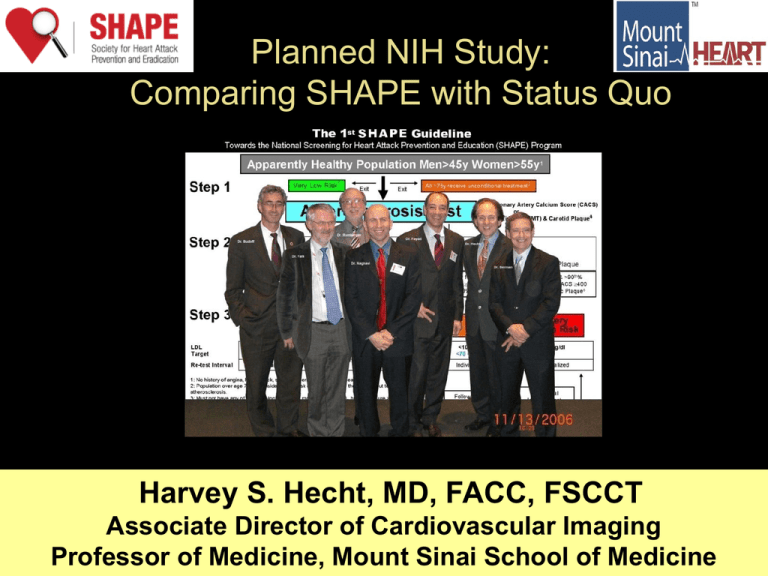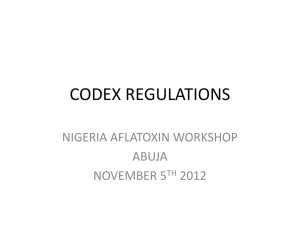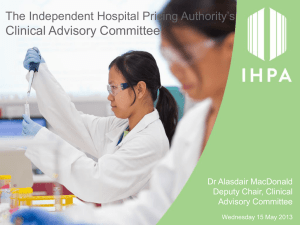
Planned NIH Study:
Comparing SHAPE with Status Quo
Harvey S. Hecht, MD, FACC, FSCCT
Associate Director of Cardiovascular Imaging
Professor of Medicine, Mount Sinai School of Medicine
Do we need an NIH RCT?
“Imaging has at least 3 virtues”
It individualizes risk assessment beyond use of
age, which is a less reliable surrogate for
atherosclerosis burden
It provides an integrated assessment of the
lifetime exposure to risk factors
It identifies individuals who are susceptible to
developing atherosclerosis beyond
established risk factors
Grundy. Circulation 2008;117:569-573
“Imaging has at least 3 virtues”
Thus, for primary prevention, a recommendation could be
established that detection of significant plaque burden is a
preferred strategy for initiation of LDL-lowering drugs. With
such a recommendation, major risk factors and emerging
risk factors could be used as a guide for selecting subjects
for imaging more than as a primary guide for therapy
Once subclinical atherosclerosis is detected, intensity
of drug therapy could be adjusted for plaque burden
Grundy. Circulation 2008;117:569-573
“The most important role of risk factors may be to identify
the modifiable targets of risk reduction in patients with risk
already established by clinical events or significant CAC.”
Hecht. Risk factors revisited. AJC 2003;93:73-5
Taylor (16)
1634
42
5.6
0
9.3
Prognostic
Power
ofCAC>0
CAC inCACAsymptomatic
Patients
N
Arad (1)
1,173
Follow
up
Mean Age
(years)
(years)
53
3.6
Park (2)
967
67
6.4
Raggi (3)
632
52
2.7
Calcium Score
Cutoff
CAC>160
CAC >142.1
Top Quartile
Comparator
Group for
RR Calculat
CAC< 160
Relative
Risk Ratio
20.2
CAC <3.7
4.9
Lowest
Quartile
First Quartile
13
8.8
In every study,
CAC
has
been
926
54
3.3
Top Quartilesuperior
(>270)
to(5)and significantly
added
to the area
Kondos
5,635
51
3.1
CAC
No CAC
Greenland (6)
1,312
66
7.0
CAC>300
No CAC
under
the
ROC
curve
for
all
risk
factor
Shaw (7)
10,377
53
5
CAC >400
CAC <10
Arad (8)
5,585
59
4.3
CAC ≥ 100
CAC <100
based
aalyses!
Taylor
(9)
2000
40-50
3.0
CAC >44
CAC=0
Wong (4)
1795
71
3.3
CAC>1000
CAC 400-1000
CAC<100
CAC<100
10.5
3.9
8.4
10.7
11.8
8.3
4.6
Budoff (11)
25,503
56
6.8
CAC>400
CAC 0
9.2
Lagoski (12)
Becker (13)
3601
1726
45-84
57.7
3.75
3.4
CAC>0
CAC>400
CAC 0
CAC 0
Detrano (14)
Erbel (15)
6814
4487
62.2
45-75
3.8
5
CAC>300
>75th%
CAC 0
<25th%
Vliegenthart (10)
6.5
6.8 men
7.9 women
14.1
11.1 men
3.2 women
Naghavi, Falk, Hecht., et al. AJC 2006
5%
Comparison of ACC/AHA 2010 and SHAPE
ACC/AHA
SHAPE
Coronary Calcium
High (>20%)
Intermediate (10-20%)
Low to intermediate (6-10%)
Lower (<6%)
NA
IIa
IIb
III
I
I
I
+FH, DM
Treatment guidelines
Downgrade risk
Upgrade risk
no
yes
yes
yes
yes
yes
We demand
outcome studies!
Stubborn Resistance
Never Underestimate the Power of People Who Cling to
Each Other to Perpetuate the Status Quo
“If neither the CAC score nor the Framingham Risk
Score has outcome data to support it, why not use
the one with the greater prognostic power?”
“It is incumbent on the cardiology community to
temper the inflexible need for randomized trials with
the reality of 565,000 patients presenting with a
myocardial infarction annually as their first
symptom, 95% of whom could be identified as high
risk by CAC and aggressively treated to significantly
reduce events.”
AJC 2008;101: 1085-7
Conclusions: As with many interventions intended to prevent ill health, the
effectiveness of parachutes has not been subjected to rigorous evaluation by
using randomised controlled trials. Advocates of evidence based medicine
have criticised the adoption of interventions evaluated by using only
observational data. We think that everyone might benefit if the most radical
protagonists of evidence based medicine organised and participated in a
double blind, randomised, placebo controlled, crossover trial of the
parachute.
Smith. BMJ 2003;327:1459–61
Is this a joke?
High Risk
Jumping from an airplane
High CAC
Treatment
Parachute
Aggressive medical rx
“Randomized controlled trials are not necessary to prove that
treatment of high-risk patients saves lives. If a randomized
controlled trial were performed and failed to show that
treatment of CAC-identified high-risk patients saved more
lives, the fault would lie with the treatment rather than the
test.”
Hecht. JACC 2010;55;1118-1120
CAC Absolute Event Rates in Asymptomatic Patients
Annual Event Rate (%)
St. Francis
N
4613
f/u (yrs)
4.3
Age
CAC
0
1-100
100-400
>400
>1000
0.13
0.23
1.28
3.26
Becker
MESA
HNR
Rotterdam
1726
3.3
62.2
6722
3.8
57.7
4129
5
60
1795
3.3
71
CAC
CAC
0-10 0.24
11-100 1.32
4.6 100-300
5.3 >300
CAC
0-100
0.11 0.17
0.7
0.59 0.28
1.43 0.66 100-400 1.64
2.87 1.65 400-1000 2.25
3.7
Summary of CAC Absolute Event Rates
CAC
0
1-100
100-400
>400
>1000
FRS Risk
10 yr event rate
very low
1.1-1.7 %
low
2.3-5.9 %
intermediate
12.8-16.4 %
high
22.5-28.6 %
very high
37 %
Reclassification of FRS Risk by CAC
Primary Prevention Outcome Studies
Study
MESA
FRS 0-6%
FRS 6-20%
FRS>20%
NRI
Heinz Nixdorf
FRS<10%
FRS 10-20%
FRS>20%
NRI
Rotterdam
FRS<10%
FRS 10-20%
FRS>20%
NRI
% Reclassified
N
Age
Follow up
(yrs)
5.8
5878
62.2
4487
45-75
5.0
2028
69.6
9.2
11.6%
54.4%
35.8%
25%
15.0%
65.6%
34.2%
22.4%
12%
52%
34%
19%
Hecht. J Diabetes. 2012: In Press
Distribution of CAC by FRS in MESA:
Potential Implications for Coronary Risk Assessment
5660 asymptomatic pts
CAC
>0
>100
>300
Prevalence
46.4%
20.6%
10.1%
FRS
CAC>300
0-2.5%
1.7%
2.6-5%
4.4%
5.1 -7.5% 7.5%
7.6-10% 13.1%
10.1-15% 15.6%
15.1-20% 24%
>20%
30%
Okwuosa. JACC 2011;57:1838–45
NNS
59.7
22.7
13.4
7.6
6.4
4.2
3.3
Interplay of CAC and Traditional Risk Factors for Prediction of
All-Cause Mortality in Asymptomatic Individuals
44, 052 asymptomatic pts
5.6±2.6y f/u
RF: current cigarette smoking
dyslipidemia
diabetes mellitus
hypertension
Events/1000
person y
0 RF, CAC 400
≥3 RFs, CAC 0
16.89
2.72
Nasir. Circ Cardiovasc Imaging. 2012; 5:467-473
0 CAC
RF
5 y all
cause
mortality
0
1
99.7% 99.3%
2
>3
99.3%
99.0%
Interplay of CAC and Traditional Risk Factors for Prediction of
All-Cause Mortality in Asymptomatic Individuals
Nasir. Circ Cardiovasc Imaging. 2012; 5:467-473
Yield of Screening for CAC in Early Middle-Age Adults Based on the
10-Year FRS: The CARDIA Study
2831 asymptomatic pts
33-45y
FRS
>0 NNS
Total
9.9%
0-2.5%
7.3% 14
2.6-5%
20.2% 5
5.1-10% 19.1%
5
>10%
44.8%
2
>5%
>2.5%
22.7 %
23.0%
>100
1.8%
1.3%
2.4%
3.5%
17.2%
NNS
79
41
29
6
3.6
4.3
>10% FRS cutoff
Editorial suggests >5% FRS cutoff: high risk with >0 CAC in >5% FRS in PACCS study
Okwuosa . JACCImg 2012;5:923–30
The Value of Imaging in Enhancing
the Wellness of Your Heart Trial:
The VIEW Your Heart Trial
February 16, 2011
Background
• CAC known to predict CHD events, beyond FRS
• CAC testing increasing in population
• Value of CAC testing to enhance CHD prevention
unknown
• Costs of CAC testing potentially great
• Risks of CAC testing small but real
• Trial of value of CAC testing to inform CHD
prevention needed
Background
• CAC known to predict CHD events, beyond FRS
• CAC testing increasing in population
• Value of CAC testing to enhance CHD prevention
unknown
• Costs of CAC testing potentially great
• Risks of CAC testing small but real
• Trial of value of CAC testing to inform CHD
prevention needed
The Things to Come of SHAPE:
Cost and Effectiveness of Cardiovascular Prevention
Performance of alternative strategies for cardiovascular prevention____
Metric
Treat All
NCEP
SHAPE___
Test targets
0
50 million
50 million
Treatment candidates
50
50million
million
15
15million
million
12.5
12.5million
million
Expected events
500,000
250,000
400,000
Expected deaths
100,000
50,000
80,000
Prevented events
150,000
75,000
120,000
LYEs
900,000
450,000
720,000
Prevented deaths
30,000
15,000
24,000
Life-years
390,000
195,000
312,000
Testing cost
0
$5 billion
$20
$20billion
billion
Treatment cost
$36 billion
$10.8 billion
$9
$9billion
billion
Gross cost
$36 billion
$15.8 billion
$29
$29billion
billion
Treatment savings
$15 billion
$7.5 billion
$12
$12billion
billion
Net cost
$21
$21billion
billion
$8.3
$8.3billion
billion
$17 billion
Cost/LYE
$23,333
$23,333
$18,444
$18,444
$23,611
$2,778
$23,611
CAC $400
Diamond & Kaul. Am J Cardiol 2007;99:1013–5
The Things to Come of SHAPE:
Cost and Effectiveness of Cardiovascular Prevention
Performance of alternative strategies for cardiovascular prevention____
Metric
Treat All
NCEP
SHAPE___
Test targets
0
50 million
50 million
Treatment candidates
50
50million
million
15
15million
million
12.5
12.5million
million
Expected events
500,000
250,000
400,000
Expected deaths
100,000
50,000
80,000
Prevented events
150,000
75,000
120,000
LYEs
900,000
450,000
720,000
Prevented deaths
30,000
15,000
24,000
Life-years
390,000
195,000
312,000
Testing cost
0
$5 billion
$20
$5 billion
billion
Treatment cost
$36 billion
$10.8 billion
$9
$9billion
billion
Gross cost
$36 billion
$15.8 billion
$29 billion
$14
Treatment savings
$15 billion
$7.5 billion
$12 billion
Net cost
$21
$21billion
billion
$8.3
$8.3billion
billion
$17
$2 billion
billion
Cost/LYE
$23,333
$23,333
$18,444
$18,444
$23,611
$23,611
$2,778
CAC $100
Diamond & Kaul. Am J Cardiol 2007;99:1013–5
The Things to Come of SHAPE:
Cost and Effectiveness of Cardiovascular Prevention
Net cost per LYE saved
-$32
$23
CAC$100
$400
CAC
Diamond & Kaul. Am J Cardiol 2007;99:1013–5
$28
$28
$106
$22
The AAPM Position Statement on Radiation Risks from Medical Imaging Procedures
Policy date 12/13/2011
The American Association of Physicists in Medicine (AAPM) acknowledges that
medical imaging procedures should be appropriate and conducted at the lowest
radiation dose consistent with acquisition of the desired information. Discussion of
risks related to radiation dose from medical imaging procedures should be
accompanied by acknowledgement of the benefits of the procedures. Risks of
medical imaging at effective doses below 50 mSv for single procedures or 100 mSv
for multiple procedures over short time periods are too low to be detectable and may
be nonexistent. Predictions of hypothetical cancer incidence and deaths in patient
populations exposed to such low doses are highly speculative and should be
discouraged. These predictions are harmful because they lead to sensationalistic
articles in the public media that cause some patients and parents to refuse medical
imaging procedures, placing them at substantial risk by not receiving the clinical
benefits of the prescribed procedures.
AAPM members continually strive to improve medical imaging by lowering radiation
levels and maximizing benefits of imaging procedures involving ionizing radiation
Study Question
• Is a coronary heart disease (CHD) risk management
strategy that is guided by the coronary artery calcium
(CAC) score associated with fewer CHD events than
usual care among individuals who are at relatively
low risk?
• Specifically: In a population with 10-year FRS for
CHD of 5 to <10%, does treatment of CAC+ persons
with statin therapy lead to fewer CHD events versus
usual care?
Study Population
•
•
Screening criteria
– Age ≥ 45 for men, ≥55 for women
– Free of DM, CVD
– Not treated with statins or other lipid-lowering medication
– Lipids, BP, smoking measured within 1 year
– Target people 5 to <10% 10-year Framingham risk for CHD
Inclusion criteria
– Asymptomatic men and women with Framingham risk score 5 –
9.9% + LDL < 160 (may add FRS 10–19.9% + LDL < 130 or <100)
– Age ≥ 45 for men, ≥55 for women
•
– No statin use within the previous 6 weeks
– No evidence of prior CVD, diabetes, or other CHD risk-equivalent (e.g.,
PAD)
Exclusion criteria
– Known CVD
– Contraindication to statin therapy
Intervention
• For CAC = 0, no medication recommended
• For CAC > 0, statin recommended (dose depends
on score)
– 40 mg Atorvastatin for CAC > 0 and ≤ 100
– 80 mg Atorvastatin for CAC > 100
• Medication provided by study
Outcomes
• Primary: Major CHD event
– Composite of CHD deaths and nonfatal acute
coronary syndromes (includes revascularization)
– Like MESA’s all CHD outcome
• Secondary
– Components of primary outcome
– Revascularization and resuscitated cardiac arrest
– HRQL/Cost effectiveness
– Adherence
– Incidental findings
Primary Assumptions for Sample Size
Assumption
Source
Framingham risk score (FRS)
distribution at baseline
Recruitment targets with some noise
Conditional distribution of CAC score
by FRS
MESA
Event rates by CAC score
MESA
Statin dose distributions by FRS and
CAC
Literature (observational data)
Effect sizes (hazard ratios) for statin
treatment
Literature (trial data)
Racial Breakdown
Assumed to be 75% white, 2%
Chinese, 15% African American, and
8% Hispanic (using the MESA
categories)
Assumed Effect Sizes
• 40 mg Atorvastatin for CAC>0 and ≤100
• 80 mg for CAC > 100
•
Dose
HR
0 mg
1
40 mg
0.781.3+0.41 ≈0.654
80 mg
0.781.3+0.62≈0.621
Data sources
– 0.78: RR for a 1 mmol/L LDL reduction (Cholesterol Treatment Trialists’ (CTT) Collaboration,
Lancet, November 2010. DOI:10.1016/S0140-6736(10)61350-5.)
– 1.3: Reduction in LDL (mmol/L) for 10 mg Atorvastatin vs. placebo (ASCOT-LLA. Sever PS,
et al. Lancet 2003; 361: 1149–58.)
– 0.41: effect of atorvastatin 40 vs. 10, given estimate of 0.62 mmol/L reduction for 80 vs. 10
(Cholesterol Treatment Trialists’ (CTT) Collaboration, Lancet, November 2010.
DOI:10.1016/S0140-6736(10)61350-5.)
– 0.62: Reduction in LDL (mmol/L) for 80 vs. 10 mg (TNT. LaRosa JC, et al. NEJM
2005;352:1425-35.)
Framingham Risk Score Distribution
• Target people 5 to <10% 10-year Framingham risk
for CHD (Wilson et al, Circulation 1998)
• Final FRS score determined at baseline, expect
some in other categories due to variability
•
FRS
Proportion
<5%
7.5 %
5 to <10%
84.5 %
10 to <20%
7.5 %
≥20%
0.5 %
Distribution of CAC Scores
• Based on MESA participants without diabetes
• Weighted using our expected racial distribution
CAC Score
FRS for CHD
0
>0 to ≤100
>100
<5%
53.5%
25.3%
21.2%
5 to <10%
48.7%
30.2%
21.0%
10 to <20%
32.2%
29.7%
38.1%
≥20%
32.2%
29.7%
38.1%
Total
47.7%
29.8%
22.5%
CHD Event Rates by CAC
• Based on MESA participants without diabetes and
with FRS 5 to <10%
CAC Score
One Year
Rate (%)
Ten Year
Rate (%)
Hazard
Ratio
0
0.17
1.6
1
>0 to ≤100
0.48
1.3
2.92
>100
4.7
12.0
7.75
• Assumes exponential model for conversion
Statin Dose Distributions
Untested
•
FRS
0 mg
<5%
0.99
0.01
5 to <10%
0.9
10 to <20%
≥20%
10 mg 80 mg
CAC
0 mg
10 mg
80 mg
0
0
0.9
0.1
0
0.1
0
>0 to ≤100
0.2
0.7
0.1
0.65
0.32
0.03
>100
0.1
0.25
0.65
0.5
0.3
0.2
Adherence estimates untested group
–
•
Tested
Kuklina EV, et al. JAMA. 2009;302:2104-10
Adherence estimates CAC-tested group
–
–
EISNER Study (unpublished data)
Kalia NK, et al. Atherosclerosis 2006; 185:394–9.
Secondary Assumptions for Sample Size
Assumption
Value
Significance Level
0.05 (two-sided)
Dropout
2 %/year
Recruitment
2 years (uniform)
Study Length
6 years (5 year average follow-up)
Proportion tested
0.5
Sample Size
• 20,968 for 80% power
• 28,068 for 90% power
Budget
• $70 million
Comparison of ACC/AHA 2010, SHAPE and NIH
ACC/AHA
SHAPE
NIH
Coronary Calcium
High (>20%)
Intermediate (10-20%)
Low to intermediate (6-10%)
Lower (<6%)
na
IIa
IIb
III
I
I
I
+FH, DM
no
no
TBD
no
Treatment guidelines
Downgrade risk
Upgrade risk
no
yes
yes
yes
yes
yes
TBD
TBD
TBD
Since ~50% will have 0 CAC, and will contribute very few
events, it may be difficult to demonstrate a positive result
After 8 years and $70 million a positive result will reinforce CAC
use only in low to intermediate group (6-10%) unless
intermediate group is added
Randomized Controlled Trials, the guide(line) dog
But there are no outcome
studies for high, intermediate
and low risk patients!
Comparison of ACC/AHA 2010 and SHAPE
ACC/AHA
SHAPE
Coronary Calcium
High (>20%)
Intermediate (10-20%)
Low to intermediate (6-10%)
Lower (<6%)
NA
IIa
IIb
III
I
I
I
+FH, DM
Treatment guidelines
Downgrade risk
Upgrade risk
no
yes
yes
yes
yes
yes
Carotid IMT/Plaque
High
Intermediate (10-20%)
Low to intermediate (6-10%)
Lower (<6%)
NA
IIa
NA
NA
I
I
I
+FH, DM
IIa,b
Int risk
CRP
CIMT in Cardiovascular Risk Prediction: A Meta-analysis
14 population-based cohorts, 45 828 pts
Median f/u 11 y, 4007 first MI or CVA
C statistic
FRS
FRS+CIMT
0.757
0.759
NRI
0.008 (all pts)
0.036 (IR pts)
CIMT (per 0.1mm increase)
“The addition of CIMT to the FRS was associated with small improvement in
10-year risk prediction of first-time MI or CVA, but this improvement is
unlikely to be of clinical importance.”
Den Ruijter. JAMA. 2012;308:796-803
“High Risk Plaque Initiative”: Bio-Image Study
Methods: 6,100 asymptomatic intermediate risk pts
Carotid US IMT + plaque:
All cases: Bilateral transverse sweep proximal to distal– ”manual
3D-like. Last 3,800 cases: Bilateral automated 3D recording
CAC: MDCT
Other tests: ABI, Abd US
2.000 with “positive” findings: CCTA and/or carotid MRA
All 6,100 followed for 3 years; compared to a 1,300 non-imaging
cohort.
End-points: Death, MI and stroke.
Sillesen. SHAPE 2010
Carotid Plaque Burden as a Measure of Subclinical Atherosclerosis:
High Risk Plaque Bioimage Study
6101 asymptomatic pts; mean age 68.8y
Int FRS (6-20%) 65.3%
Carotid plaque
78%
Abnl ABI
10%
AAD >20mm
28%
CAC
68%
0
32.1%
1-100
29.0%
101-400 22.2%
>400
16.8%
Association with CAC
Marker
N
Plaque burden
5927
CIMT (continous) 5923
CIMT (quartiles) 5923
Aortic diameter
ABI
4940
5879
Multivariate
HR
T3
4.79
T2
2.73
T1
1.70
1.14
Q4
1.46
Q3
1.21
Q2
1.13
1.05
1.65
Sillesen. J Am Coll Cardiol Img 2012;5:681–9
Wald Chi
Square
450.0
24.0
28.5
2.9
35.2
p
<0.0001
<0.0001
<0.0001
0.091
<0.0001
Framingham and Plaque Presence
Carotid Plaque Presence/Absence
Plaque presence and CAC
PHASE 1 - COMPARATIVE PREVALENCE BETWEEN DEGREE OF CAC
AND DEGREE OF CAROTID PLAQUE BURDEN BY 3D SWEEP
IMT vs CAC:
NS
(n = 1456)
(n = 1456)
(n = 1457)
(n = 1454)
U Baber, R Mehran, P Muntendam, M Garcia, H Sillesen, E Falk, V Fuster, 2012
PHASE 2 - BioImage And CardioScore:
Significant Risk Prediction For Primary Events
N=3557 for all plots that have 3D carotid US
CACS
3D carotid ultrasound
CardioSCORE
blood test
Cumulative Event Rate by Category
P Muntendam, E Falk, V Fuster 2012
PHASE 2 - Significant Addition of Risk Prediction
By CACS + Carotid US – Addition to FRS ? #
#Based on Phase 1, Suspect a Very Significant Addition.
PHASE 1 - PLAQUE BURDEN - 3D US SWEEP
PRIMARY EVENTS - N=186, 18 MONTHS
H Sillesen, E Falk,
P Muntendam, V Fuster,
JACC Img 2012 (Subm)
Variables
Burden, > 4.20 cm2
OR (95% CI)
P value
3.63 (2.26-5.82) <0.0001
Chi-square
28.5
Burden, 2.58-4.20 cm2
1.83 (1.09-3.05)
0.022
5.3
Burden, 0.01-2.57 cm2
1.15 (0.65-2.00)
0.64
0.2
“High Risk Plaque Initiative”: Bio-Image Study
3D plaque analysis reveals that plaque is much more
prevalent than previously thought
Plaque tracks CAC; IMT does not
High percentage (70%) of plaque in 0 CAC pts mandates
plaque be evaluated with a minimum abnormal volume
and a graded scale for risk assessment
HRP outcomes will affect screening recommendations
The 2nd S.H.A.P.E. Guideline
Coronary Artery Calcium
Score (CACS)
or
Carotid Plaque Burden
Carotid Plaque present
0 Carotid Plaque
Lowest Tertile
Carotid Plaque
Lowest Risk
Low Risk
CACS 100-399 &<75th%
CACS>400 or >75th%
Middle Tertile
Carotid Plaque
Highest Tertile
Carotid Plaque
Intermediate
Risk
High
Risk
Guidelines vs. Rules
•Venkman: I make it a rule
never to get involved with
possessed people.
•Actually, it's more of a
guideline than a rule...
We must avoid the “cognitive dissonance” that
often impedes forward progress and confines
guidelines to the necessity of the RCT, to
optimize the care of our patients in light of the
available evidence.
Blumenthal JACC 2011;57:1601–3
For patients undergoing risk evaluation:
Superior doctors use CAC
Mediocre doctors use the FRS and hope their patient is still alive
when the RCT is complete
Inferior doctors are so biased that they will never use CAC
--Huang Dee: Nai-Ching
(2600 BC First Chinese Medical Text)




